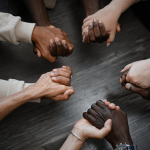Nick Kristof wrote last weekend about the American Academy of Pediatrics’ new policy statement on “toxic stress” as a precursor to all sorts of physical and psychological ailments. When infants and young children are subjected to stressors, including abuse and neglect, and when they don’t receive adequate parental love as an antidote to that stress, they are more likely to grow up sick, poor, and involved in crime.
My first thought upon reading this (other than that it makes complete sense) was that the way to ensure that babies are free from toxic stress is to make sure their moms are free from toxic stress—that their moms are healthy and happy. I mean no offense to fathers, who are utterly capable of lavishing care and attention on their children. But babies’ welfare is so physically intertwined with mothers’ welfare—women incubate, birth, nurse, and frequently provide the bulk of physical care for infants and toddlers—that making sure that Mom’s needs are met will go a long way toward ensuring that she can provide all that her baby needs, from lavish affection to healthy food and a home in which respectful, nonviolent relationships are the norm. Kristof hints at this connection when he mentions the success of a program that sends nurses to the homes of young mothers, helping them to quit smoking, eat well, and provide the kind of nurturing attention their children crave.
I thought of Kristof’s column when I read this provocative blog post by writer Sarah Moon titled I’m Pro-Life. I’m Pro-Choice. I’m Pro-Woman. Moon does a good job, in relatively few words, outlining the gray areas of both pro-choice and pro-life positions. Moon’s overall point is that women’s welfare is intimately tied to the circumstances influencing abortion; rape and economic vulnerability and abusive relationships lead some women to feel that they truly don’t have any “choice” other than abortion. Moon concludes:
No matter your stance on the abortion issue, we all need to strive toward making the world a better place for women. I believe that, if both sides would put aside their picket signs and politics, and work together to free and empower women, I believe we’d see the abortion rates drop.
Kristof and Moon both point to a simple but vital truth: Take care of women, and you’ll also be taking care of their children. This idea is also evident in developing countries, where groups like Kiva have found that making even modest resources available to women (microloans and such) can lead to significant improvements in poor communities.
In another related article, Sojourners reported on a survey indicating that Sarah Moon’s identification of herself as both “pro-choice” and “pro-life” is not just semantic wizardry. In fact, this survey found that a majority of Americans believe both that abortion should be legal, and that it is morally wrong. One of the researchers notes that, “The binary ‘pro-life’ and ‘pro-choice’ labels don’t reflect this complexity.” My observation? Few moral quandaries of substance can easily be divided into black and white. And when we insist on seeing complex issues in black and white anyway, we fail to engage in moral discourse that is meaningful. We fail to have conversations that actually lead to consensus or greater understanding, and instead fall back on lobbing sound bites and slogans toward the “other side.”
I think that abortion is a moral tragedy. I also think it should be legal. (I and my friend and colleague Karen Swallow Prior held an open online dialogue about our respective positions on abortion on Amy Julia Becker’s Thin Places blog back in November. Here’s Karen’s first post and my first post in the series, which continued with several follow-up posts later in the month.) Apparently, I’m not alone in holding these two views simultaneously.











